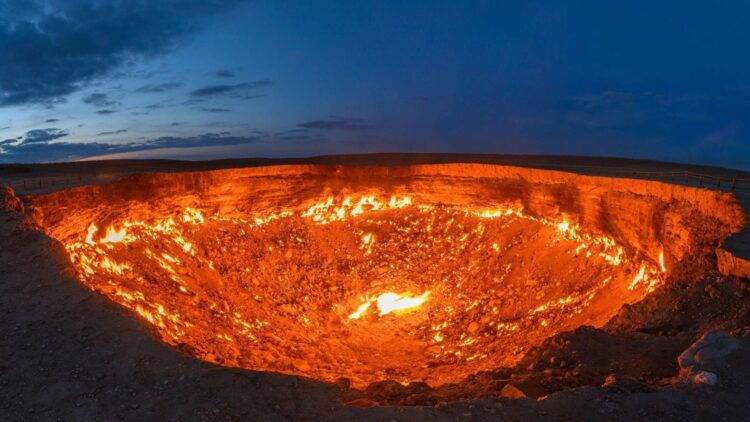Since the 1960s, an unknown fire has occurred in the Karakum desert in Turkmenistan. Called the “Gates of Hell” due to this flammable gas, methane, the fire has attracted thousands of tourists to watch its glow.
But now, the government of Turkmenistan has decided that it is time to shut the door—though nobody can put out the fire that has been burning since 1971. What can be done to douse a fire that has been burning for over half a century?
The fascinating and fiery history behind the Gates of Hell in Turkmenistan
The story of the Gates of Hell starts in 1971 after a drilling accident in the Soviet when the Darvaza gas crater was formed. A drilling rig hit a natural gas pool, and the ground gave way, leading to a huge gas eruption. To avoid an environmental catastrophe, Soviet researchers planned to ignite the gas to burn off methane in several weeks.
The fire remained ignited for several years, burning the desert with the help of the large quantity of natural gas trapped beneath the surface. At present, it has a diameter of 70 meters and a depth of 30 meters and is still blowing out gas and flames into the sky.
As the Gates of Hell has become one of Turkmenistan’s top landmarks, its negative effect on the environment cannot be dismissed. Over the years, the fire has raised concern in several ways since it has been discovered to hurt the environment and people living around the fire area.
The country’s president, Gurbanguly Berdymukhamedov, has expressed concerns about continued methane emissions, a potent greenhouse gas, from the crater.
Moreover, the gas emitted from the crater is hazardous to the health of inhabitants living close to the crater region. To avoid such consequences, Berdymukhamedov ordered the fire to be put out and appealed to the specialists to work on it.
The difficulty of extinguishing a flame that has burned for decades
The choice of shutting the Gates of Hell raises a great dilemma. Natural gas still bubbles through the ground from the Amu-Darya Basin of Turkmenistan and Uzbekistan, so it is impossible to stop the fuel supply to the crater altogether.
This has created a scramble to find a solution, with the government putting out the fire threatening a viable solution and experts disagreeing on how to tackle the problem. Others believe the fire could be extinguished only by capping the gas leak, and they do not know what would follow.
Some people think the direction of the gas flow may be safer, but to do so would require much technical knowledge and equipment, which Turkmenistan may not have.
Nonetheless, the Gates of Hell attracts thousands of tourists who go through Turkmenistan yearly. It has a red hot light at night, easily seen from miles away amid the desert. The site’s appeal was further boosted in 2019 when President Berdymukhamedov became involved in the sideshow, filming himself driving a rally car near the crater and doing tricks on its rim.
Gathering, which used to be a sign of scientific failure, has become a cultural landmark of Turkmenistan. However, the future of this site is currently unknown, as the government recently decided to put out the fire.
Will the Gates of Hell be shut down forever or remain a cultural landmark?
The shutting of the Gates of Hell makes people wonder about the status of such a natural phenomenon. Will it go down as a scientific mistake or as an environmental landmark? As for now, the world only observes Turkmenistan as the country tries to extinguish a flame that has been burning for over half a century.
Despite the significant problems, the decision to close the Gates of Hell may be the starting point in changing the approach to managing environmental problems concerning economic and cultural values. As experts search for a solution, one thing is sure: The Gates of Hell will not quickly be closed.

